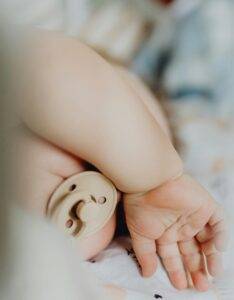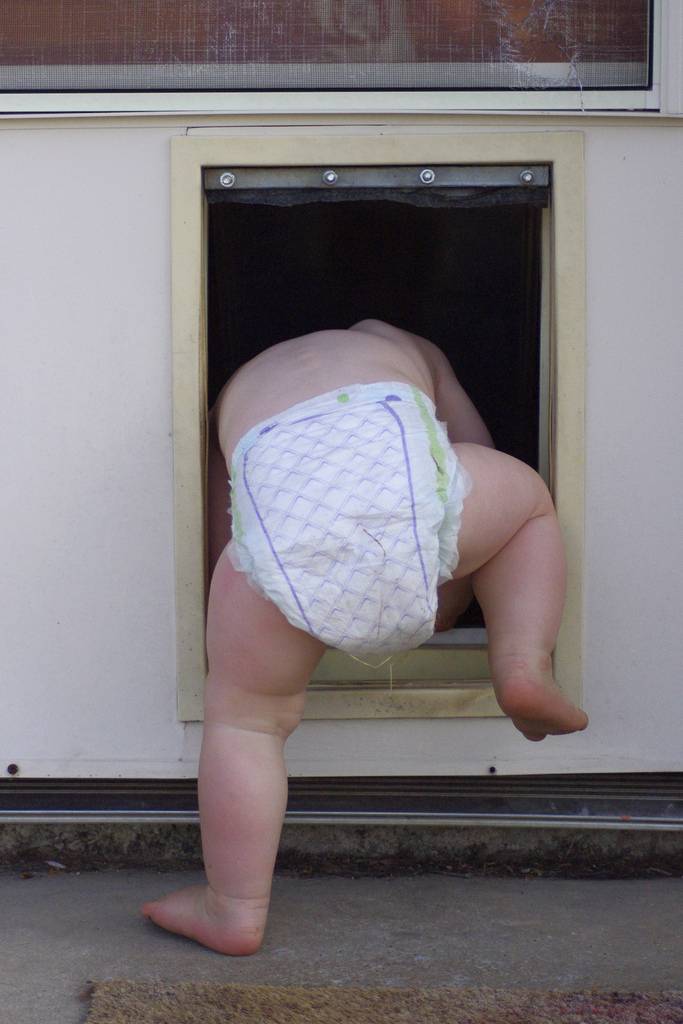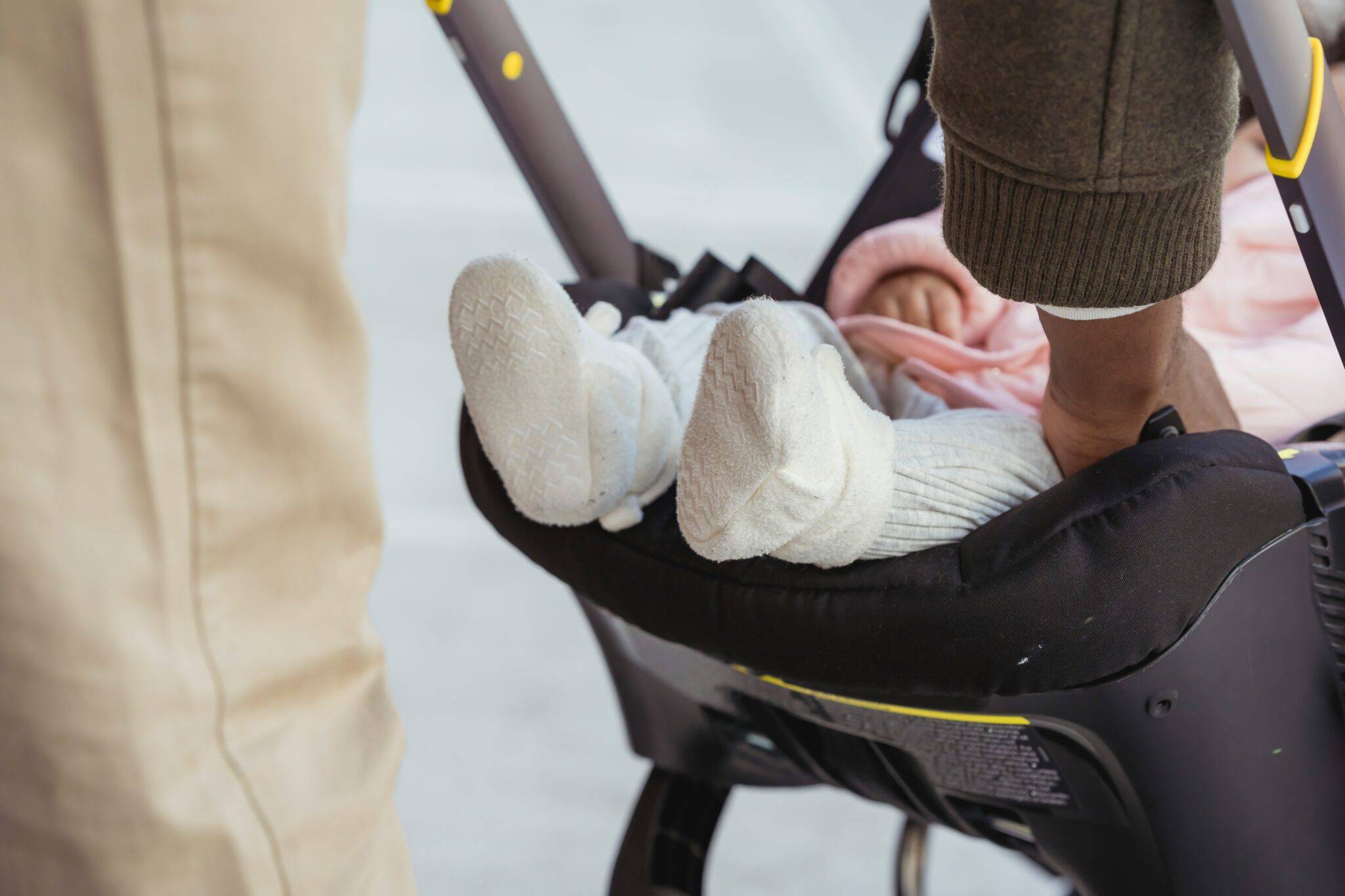As new parents, ensuring your baby is safe during sleep is one of your top priorities. Among the many questions, one often comes is, “Can a newborn baby sleep with pacifier?” The short answer is yes, but like many aspects of parenting, it has guidelines to follow.
This comprehensive guide will explore the potential benefits and risks associated with newborn baby sleep with pacifier, tips for safe pacifier use, and outline key practices for ensuring that your baby’s sleep environment is as safe as possible.
The Role of Pacifiers in Newborn Sleep
Pacifiers have been a go-to tool for calming fussy babies for generations. However, their role in a newborn’s sleep routine is often debated. To make an informed decision, understand the benefits pacifiers offer and the risks they pose.
Newborn Baby Sleep with Pacifier: The Benefits of Pacifier Use
Pacifiers are more than just a tool to soothe crying babies. When used correctly, they offer several benefits, particularly during sleep. Here are some key advantages:
- Reduced Risk of Sudden Infant Death Syndrome (SIDS): This is one of the most significant benefits—its association with a reduced risk of Sudden Infant Death Syndrome (SIDS). Studies have shown that babies who use a pacifier during sleep have a lower chance of experiencing SIDS.
While the exact reasons are still being researched, it’s believed that pacifiers keep the baby’s airway open, ensure that babies sleep in a safer position (on their backs), and prevent deep sleep that makes it harder for a baby to awaken if there’s a problem.
- Soothing and Comfort: Many newborns have a strong sucking reflex, which is why pacifiers are soothing for them. Sucking helps your baby calm down and fall asleep more easily. This is particularly helpful during those late-night wakings when your baby needs comfort to drift back to sleep.
- Promotes Self-Soothing: Pacifiers help babies learn to self-soothe. When your baby wakes up during the night, the familiar comfort of a pacifier settles them back without the need to be picked up or fed, leading to longer, uninterrupted sleep.
- Easier Transitions: Some babies are used to feeding right before sleep. A pacifier makes the transition from feeding to sleeping smoother. The sucking motion mimics breastfeeding or bottle-feeding, providing comfort and security as your baby drifts off.
Newborn Baby Sleep with Pacifier: The Risks of Pacifier Use
While pacifiers offer many benefits, they aren’t without risks. Understanding these risks helps you decide when and how to use a pacifier with your newborn.
- Risk of Dependency: This is one of the most common concerns when your baby becomes dependent on a pacifier to fall asleep. This is problematic if your baby wakes up frequently during the night when the pacifier falls out, disrupting sleep for the baby and the parents.
- Dental Concerns: Prolonged pacifier use, particularly beyond the first year of life, causes dental issues. Continuous sucking affects the alignment of a baby’s teeth and the development of their bite. These concerns are more relevant as your child grows older and are less of an issue during the newborn stage.
- Increased Risk of Ear Infections: Studies have suggested a correlation between pacifier use and an increased risk of middle ear infections as babies grow. While this risk is relatively low during the first six months—coinciding with the highest risk period for SIDS—it’s something to be aware of as your baby grows.
- Potential for Nipple Confusion: For breastfeeding mothers, introducing a pacifier too early leads to nipple confusion. This occurs when a baby has difficulty switching between the mother’s breast and the pacifier, disrupting breastfeeding. To minimize, wait until breastfeeding is well established before introducing a pacifier.
How to Safely Use a Pacifier for Newborn Sleep
If your newborn baby sleep with pacifier, follow safe practices to minimize the risks. Here’s how to safely incorporate the pacifier into your newborn’s sleep routine:
1. Choose the Right Pacifier
There are pacifiers designed for newborns for their safety and comfort. Here are some key factors to consider:
- Size and Shape: It should be appropriately sized for a newborn. Pacifiers are designed with age-specific features, and using one that’s too large or too small is a choking hazard or is uncomfortable for your baby. The shape of the nipple should be symmetrical and flat, considered to be the most orthodontically friendly.
- Material: It should be made of silicone or latex. Silicone pacifiers are more durable and easier to clean, while latex pacifiers are softer but wear out more quickly. Additionally, be mindful of potential allergies to latex.
- One-Piece Design: Opt for a pacifier with a one-piece design rather than with multiple parts. This reduces the risk of coming apart, posing a choking hazard.
- Ventilation Holes: Look for pacifiers with ventilation holes in the shield. These holes allow air to circulate, preventing skin irritation around your baby’s mouth.
2. Establishing Safe Sleep Practices with a Pacifier
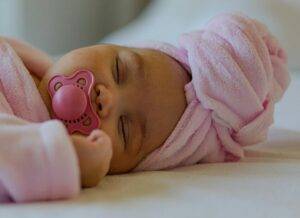
Using a pacifier during sleep is only part of creating a safe sleep environment for your baby. Here are some tips to follow:
- Always Place Your Baby on Their Back: The safest sleep position for a newborn is on their back. Whether or not your baby is using a pacifier, always place them on their back for naps and nighttime sleep. This position has been shown to reduce the risk of SIDS.
- Keep the Sleep Area Free of Hazards: Aside from the pacifier, your baby’s crib or bassinet should be free of other objects. Avoid placing pillows, blankets, stuffed animals, and bumper pads in the crib, as these increase the risk of suffocation or entrapment. A firm mattress with a fitted sheet is all your baby needs.
- Monitor Pacifier Use: If your baby falls asleep with a pacifier, it is perfectly safe to leave it in their mouth. There’s no need to replace the pacifier if it falls out after they’ve fallen asleep. Using the pacifier during sleep is what provides the benefits—not having it in their mouth the entire time they’re sleeping.
- Avoid Pacifier Clips with Cords or Strings: Never attach a pacifier to your baby’s clothing with a cord or string, as this poses a strangulation hazard. If you use a pacifier clip, it should have safety features and be short enough.
- Introduce the Pacifier After Breastfeeding is Established: If breastfeeding, wait until your baby is 3-4 weeks old before introducing a pacifier. This prevents potential interference with breastfeeding and allows you to establish a strong breastfeeding routine.
3. Know When to Remove the Pacifier from the Sleep Routine
As your baby grows, the time will come when you want to start weaning them off the pacifier, especially during sleep. Knowing when and how to do this ensures a smooth transition.
Signs to Wean Off the Pacifier
- Increased Nighttime Waking: If your baby wakes up multiple times a night since they can’t find their pacifier, start the weaning process. Frequent wake-ups disrupt sleep for your baby and the rest of the family.
- Approaching the One-Year Mark: As your baby approaches their first birthday, the risk of SIDS decreases, and the potential for dental issues due to pacifier use increases. This is a good time to wean your baby.
- Developmental Milestones: As your baby reaches developmental milestones, such as talking, consider weaning. Pacifiers interfere with speech development if used for extended time, hence, reduce reliance on them as your baby begins to babble and talk.
How to Wean from the Pacifier
When it’s time to start weaning, make it gradual to make the process smoother. Here’s how to approach it:
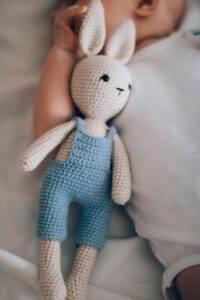
- Gradual Reduction: Start by limiting the use of the pacifier to naps and nighttime sleep only. Once your baby is comfortable without a pacifier during the day, phase it out during naps, and eventually, nighttime sleep. Gradual reduction allows your baby to adjust without a sudden loss of comfort.
- Provide Comfort Alternatives: As you reduce pacifier use, introduce other comforting items such as a soft blanket or a favorite stuffed animal. Ensure these items are safe for sleep and not suffocation risks. Transitioning to a comfort item that your baby holds eases the process.
- Use Positive Reinforcement: Celebrate the small victories as your baby learns to sleep without the pacifier. Positive reinforcement, such as gentle praise or extra cuddles, makes the transition more positive for you and your baby.
- Cold Turkey Approach: Some parents find that taking away the pacifier all at once is the most effective method. While this approach initially leads to rough nights, some babies adapt quickly when the pacifier is no longer an option. If you choose this method, be prepared for extra comfort and soothing during the first few nights.
- Offer Plenty of Love and Support: Weaning from the pacifier is a significant change for your baby, so offer plenty of love and support during this transition. Be patient and understanding as your baby adjusts to sleeping without their pacifier.
Beyond Pacifier Use: The ABCs of Safe Sleep
The ABCs of safe sleep are an easy way to remember the most important aspects of creating a safe sleep environment for your baby. Pediatric experts support these guidelines and have shown they reduce SIDS and other sleep-related issues.
- A: Alone: Your baby should sleep alone in their crib, bassinet, or portable play yard. Co-sleeping, or sharing a bed with your baby, is not recommended as it increases the risk of accidental suffocation. However, room sharing, where your baby sleeps in their own sleep space in the same room as you, is recommended for at least the first six months, ideally up to one year.
- B: Back: Always place your baby on their back to sleep. This position is the safest for newborns and infants and has been shown to reduce the risk of SIDS. Once your baby rolls over independently, you don’t need to reposition them but always start on their back.
- C: Crib: Your baby should sleep in a crib, bassinet, or play yard that meets safety standards. The sleep surface should be firm, and the mattress should fit snugly in the crib with no gaps around the edges. A fitted sheet is all needed—avoid soft bedding, blankets, and pillows, posing suffocation risks.
Room Sharing vs. Bed Sharing
Room sharing is recommended for the first six to twelve months of your baby’s life, as it has been shown to reduce the risk of SIDS. Room sharing allows you to be close to your baby during the night, making it easier to attend to their needs and reducing the likelihood of accidental suffocation.
However, bed sharing, where your baby sleeps in the same bed as you, isn’t recommended. While it might seem convenient, bed sharing increases the risk of suffocation, strangulation, and SIDS.
Dress Your Baby for Safe Sleep
Dressing your baby for sleep is also important for their safety and comfort. Overheating is linked to SIDS risk, so dress your baby appropriately for the room temperature.
- Temperature-Appropriate Clothing. Dress your baby in light, breathable clothing appropriate for the room temperature. The rule of thumb is to dress your baby in one more layer than you would be comfortable wearing in bed.
- Use Sleep Sacks. These are safe alternatives to blankets. These keep your baby warm without covering their face, which could lead to suffocation. Choose one appropriate for the season—lightweight cotton for summer and fleece for winter.
Allow Your Newborn to Sleep With a Pacifier
Allowing your newborn to sleep with a pacifier is safe and beneficial when it’s done correctly. Pacifiers offer several advantages but use them safely and be mindful of potential risks such as dependency and dental issues as your baby grows.
Incorporating pacifiers into your baby’s sleep routine should be part of a broader approach to safe sleep practices. You ensure your baby sleeps safely and soundly. For more information on caring for your newborn, check out our other helpful resources on Omegapediatrics.com:

